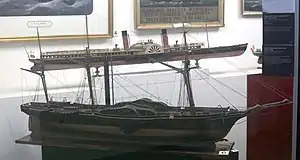 Scale model of Sésostris on display at the Musée national de la Marine in Paris | |
| History | |
|---|---|
| Name | Sésostris |
| Namesake | Ambiguous [Note 1] |
| Builder | Cherbourg[1] |
| Laid down | 21 August 1835 [1] |
| Launched | 27 August 1836 [1] |
| Acquired | 29 December 1852 [1] |
| Commissioned | 11 January 1852 [1] |
| Stricken | 25 October 1861 |
| Fate | Broken up 1896 |
| General characteristics | |
| Class and type | Rhamses-class steamer[1] |
| Displacement | 913 tonnes[1] |
| Propulsion |
|
| Armament |
|
| Armour | Timber |
Sésostris was a paddle steamer, initially built as a postal steamer for the Near Eastern service of the Messageries Maritimes. In 1852, she became a steam aviso in the French Navy.
Career
From 1853 to 1854, Sésostris cruised off Western Africa under Lieutenant Chastenet.[1]
In 1855, she was re-armed with mortars for the Crimean War, notably taking part in the Battle of Kinburn.[1]
In 1859 and 1860, she performed oceanographic surveys off Newfoundland.[1]
Struck in 1861, she was used as a floating mechanics workshop until 1894. She was eventually broken up in 1896.[1]
Legacy
A model of Sésostris is on display at the Musée national de la Marine in Paris.[2]
Notes
Citations
References
This article is issued from Wikipedia. The text is licensed under Creative Commons - Attribution - Sharealike. Additional terms may apply for the media files.